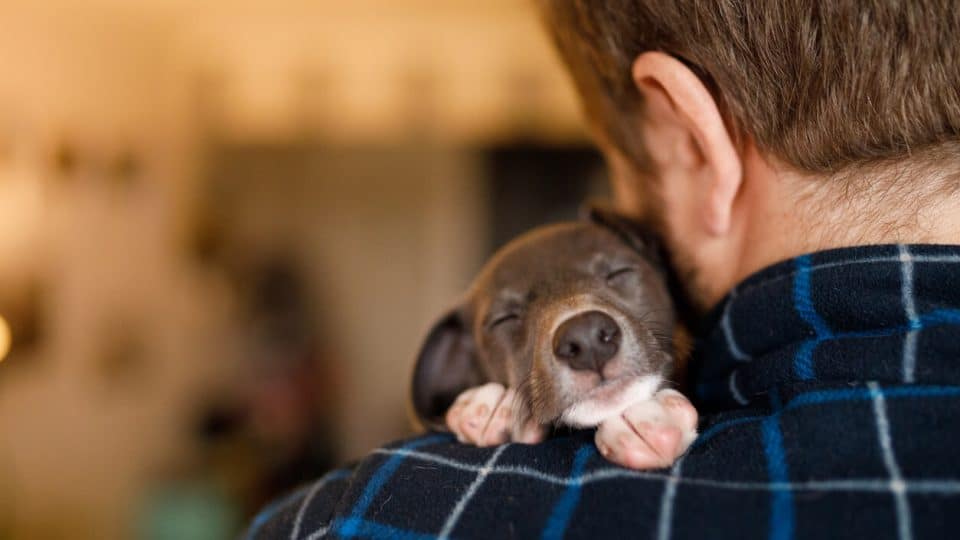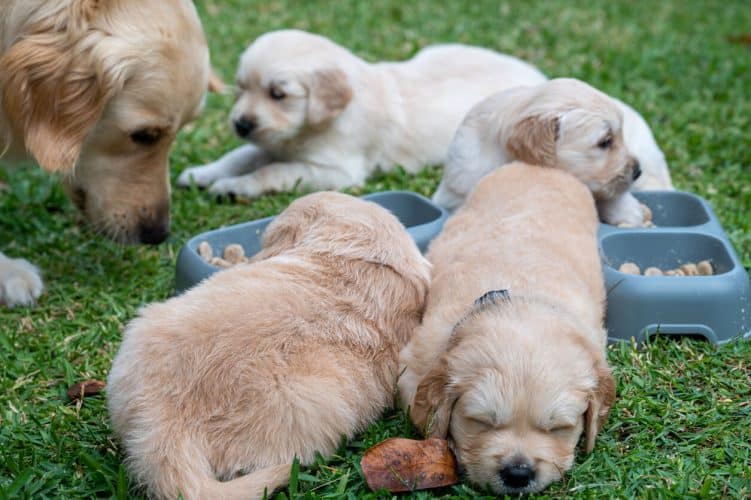- Not a substitute for professional veterinary help.
It’s no secret that puppies grow quickly. But once you bring your new puppy home, you’ll soon realise that every stage of puppy development is just as important as the next.
When your puppy joins your family—sometime between the age of eight and 14 weeks—you’ll discover that every month comes with something new.
Whether you’ve just adopted a new puppy or are preparing to choose one to join your family, here’s what to expect at each puppy stage, month by month.
One Month (0-4 Weeks)
Also known as the neonatal and transitional stages, this part of your puppy’s life will progress quickly. By weeks two and three, your puppy’s eyes and ears begin to open. Then they begin to get their bearings and take their first puppy steps.
By week three, your puppy has stumbled upon one of the most important puppy milestones: the critical socialisation period. The socialisation period spans about three to 16 weeks. At this time in a puppy’s development, they’re most open to learning.
Puppies during the socialisation period may experience feelings of happiness when playing with littermates or interacting with human caregivers, explains Sophie Barton, a PhD candidate at The Canine Brains Project at Harvard University. She studies how selective breeding and training shapes the canine brain.
Key puppy milestones at one month:
- Newborn: Puppies can sense body heat, smell, suckle, and crawl
- Week 2: Puppies begin developing baby teeth
- Week 2-3: Puppies’ eyes and ears open
- Week 4: Puppies can stand and take their first steps
- Socialisation period: Puppies express fear when separated from their mother and littermates
At this stage, puppies are still too young to leave their mothers. They need her milk for nutrients, but they also need to learn important social skills from her and their littermates, explains Darris Cooper, CPDT-KA, FFCP, national dog training manager at Petco.
Two Months (4-8 Weeks)
By four or five weeks, puppies are starting to go, go, go. They’re wobbling around beyond the comfort of mum and seeking out play with littermates and human caregivers. It’s a busy month for puppies for other reasons too: They’ll begin weaning and using the bathroom on their own.
By month two, you can start potty training. Puppies are still too small to ‘hold it’ for long, so they’ll need hourly toilet breaks with consistent positive reinforcement.
Key puppy milestones at two months:
- Week 4-5: Puppies seek out play with littermates and human caregivers
- Week 5: Toilet training begins
- Week 6-8: Puppies receive their first set of core vaccines
- Week 7: Puppies can fully transition to solid food
- Week 8: Puppies may be ready to join their forever family
- Week 8-10: Your puppy has a full set (28 teeth) of baby teeth
Toward the end of month two, your puppy’s caregiver will consult a veterinarian about essential puppy vaccinations.
Core vaccinations, which occur between six and eight weeks, include distemper, adenovirus, leptospirosis, parvovirus, and parainfluenza. After your puppy comes to you, they’ll usually need two more boosters of the vaccines. Depending on where your puppy lives and their expected lifestyle, they may receive other, optional vaccines.
Cooper says most puppies are old enough to leave their mothers and littermates by eight weeks, but the ideal age will vary depending on the breed of dog and the puppy’s individual socialisation. Some puppies leave their mum as late as 14 weeks old.
Three Months (8-12 Weeks)
Your puppy is the most impressionable during this period, Cooper says. And while it’s important to continue introducing them to new stimuli as they near the end of the socialisation window, keep in mind that they’re very sensitive to anything new. In fact, this month is sometimes called the ‘fear period’.
Key puppy milestones at three months:
- Puppies can leave their mum and go to their forever home
- Puppies weighing at least 1kg may be old enough for spaying or neutering (though this is not normally recommended)
- Puppies get their second set of core vaccines
- Fear of new things develops, and puppies rely on their pet parents for comfort
- Puppies can start obedience classes once they’ve received their core vaccines
- According to Cooper, puppies form their deepest relationships with their pet parents at three months
“It’s important for pet parents to be patient during this time and create as many good experiences for their pups as possible using positive reinforcement,” Cooper says. This may include introducing your puppy to their future pet sitter early on, so that they don’t develop a fear of being left alone with a stranger. “If your puppy does get scared, be sure to offer comfort.”
He suggests pairing new “scary” experiences with something positive, like puppy treats or play. This is called desensitisation, and if you sign your puppy up for obedience classes (Cooper recommends it!), your puppy is sure to get lots of practice.
Some shelters and rescues will send puppies home spayed or castrated to prevent intentional breeding. However, most vets recommend waiting closer to the six-month mark or longer before neutering them.
Four Months (12-16 Weeks)
Don’t be alarmed if you find a puppy tooth in the carpet at this time. When puppies are 12 to 16 weeks old, they start developing their adult chompers. But puppy teething also comes with a few challenges, like managing puppy biting.
“I recommend choosing a pet-safe chew toy or a rawhide-free treat to protect your pet’s teeth and health,” Cooper says. Freezing your puppy’s favourite toy or giving them a frozen dog-safe snack can also soothe their gums.
Key puppy milestones at four months:
- Puppies start to lose their baby teeth and develop their permanent, adult teeth
- Puppies get their third set of core vaccines
- Your puppy will have plenty of energy, but they can’t exercise for as long as adult dogs
- Reliance on consistent and clear communication from pet parents accelerates at this age
Teething aside, your puppy’s unique personality will start to emerge around the age of 12 weeks. They’ll need continued socialisation to develop good social skills, practise potty training, and become an overall well-mannered pup. Controlled play with other dogs is a great way to achieve this.
Five Months (16-20 Weeks)
Your curious puppy will start to show their independence. Just keep in mind that their exploration—or pushing the boundaries on house rules—isn’t ‘naughty’, but part of their development.
To prevent your puppy from getting into trouble, puppy-proof your house if you haven’t already. This may involve:
- Using baby gates to restrict access to certain rooms
- Buying puppy-proof cabinet latches and garbage cans
- Crate training your puppy so you can control when and where they safely explore
Important! At five months, puppies still can’t hold their bladder for more than three hours at a time, so don’t leave them in a crate for any longer than that without a potty break.
The best way to keep your growing puppy happy, healthy, and well-socialised is to continue positive reinforcement training and ongoing classes with other dogs and their people.
Key puppy milestones at five months:
- Your puppy may shed more. This happens as they shed their puppy coat and grow their adult one.
- Your puppy’s brain is around 80% developed.
- By now, you and your puppy have bonded and their adult personality is fairly developed
Six Months (20-24 Weeks)
By six months old, most toy and small dog breeds will have nearly finished growing, while medium dogs will have slowed their growth significantly. Large and giant dog breeds, on the other hand, may keep growing until they reach one to two years of age.
If your puppy hasn’t been neutered yet, consider getting this procedure done now. Spaying and castration help reduce pet overpopulation and the risk of certain diseases. This is the most common surgery performed on pets.
By now, your puppy is settling into their adult personality and size. As you bond with your dog, it’s important to keep up their training and socialisation and make sure they receive proper puppy nutrition and vet care.
Key puppy milestones at six months:
- Most puppies have nearly finished growing, except for large and giant breeds
- Teething stops, as your puppy has all of their adult teeth, and their puppy breath goes away
- Your six-month-old puppy can now hold their pee for about six hours, Cooper says
Getting Ahead of Dog Adolescence
“Much later during puberty, dogs undergo significant hormonal changes, like human teenagers,” Barton explains. “This can change and intensify dogs’ emotions, so caregivers should be especially patient with their dogs during this period.”
These stages can be tough on the pet parent-dog bond. During this time, choose activities that give your puppy a sense of control and choice. For example, scent walks allow your dog to follow their nose and explore at their own pace.
Your dog’s ‘teenage’ behaviour may feel frustrating at times, but it’s important to stick with reward-based training and socialisation. This will help your dog learn how to behave appropriately in different situations and around other dogs and people as they reach emotional and sexual maturity.
FAQs About The First Six Months of Puppyhood
What is the hardest month with a puppy?
That depends on various factors, like how well potty training goes, whether your puppy has a difficult time teething, or if the adolescent and teenage stages prove more challenging than you expected.
If you’re having a difficult month with your puppy, remember there’s always help available. Pet charities often offer free or low-cost education, socialisation classes, and behaviourists for one-on-one guidance. Be sure to hire a dog trainer who uses positive reinforcement methods to help your puppy learn without fear or punishment.
At what age do puppies become more independent?
Puppies start to become more independent around five months old. During this time, they begin to develop their own sense of identity and explore the world around them. They may also start to push boundaries and test their limits.
How long can puppies hold their pee?
When puppies come home around eight weeks old, they’ll require potty breaks about every hour.
As puppies grow, they’ll slowly develop more bladder control, with five-month-old puppies holding their pee for three to four hours and six-month-old puppies holding their pee for up to six hours.
Adult dogs shouldn’t hold their pee for more than six to eight hours and will require at least three or four bathroom breaks a day. If you need to go into the office, consider having a drop-in dog walker to make sure your dog gets their exercise and bladder needs met.
How much exercise should puppies get?
The amount of exercise your dog needs a day depends on a number of factors, including their age, breed, overall health, and energy level. Young developing dogs shouldn’t engage in strenuous exercise, but puppies do need frequent walks for confidence and loose-lead training.
“If your puppy is not getting enough mental and physical exercise, they may resort to play-biting or destructive behaviours as a way of releasing pent-up energy,” Cooper says. If you feel unsure, ask your vet. Your vet can help determine the right amount of exercise for your dog’s age and size.
Pro tip! When booking a dog walker for your puppy, communicate your rules and why they exist. For example, when you ask your dog walker to avoid other dogs, let them know if it’s because your puppy is reactive or jumpy and you don’t want them to practise bad behaviours. Detailed instructions like this will help set your puppy up for success with obedience training.






